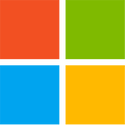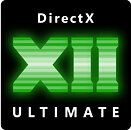Friday, March 20th 2020

Microsoft DirectX 12 Ultimate: Why it Helps Gamers Pick Future Proof Graphics Cards
Microsoft Thursday released the DirectX 12 Ultimate logo. This is not a new API with any new features, but rather a differentiator for graphics cards and game consoles that support four key modern features of DirectX 12. This helps consumers recognize the newer and upcoming GPUs, and tell them apart from some older DirectX 12 capable GPUs that were released in the mid-2010s. For a GPU to be eligible for the DirectX 12 Ultimate logo, it must feature hardware acceleration for ray-tracing with the DXR API; must support Mesh Shaders, Variable Rate Shading (VRS), and Sampler Feedback (all of the four). The upcoming Xbox Series X console features this logo by default. Microsoft made it absolutely clear that the DirectX 12 Ultimate logo isn't meant as a compatibility barrier, and that these games will work on older hardware, too.
As it stands, the "Navi"-based Radeon RX 5000 series are "obsolete", just like some Turing cards from the GeForce GTX 16-series. At this time, the only shipping product which features the logo is NVIDIA's GeForce RTX 20-series and the TITAN RTX, as they support all the above features.Microsoft's announcement of the logo invited quick reactions from NVIDIA and AMD. NVIDIA has reason to gloat that its circa Q3-2018 GeForce RTX 20-series are already DirectX 12 Ultimate logo certified, and gloat it did. AMD, on the other hand, was left to content with the fact that Xbox Series X has this logo, as its upcoming RDNA2 graphics architecture powers the console's GPU; and an assurance that its next-generation of Radeon RX graphics cards will feature the logo. Intel posted no reaction to this development, since none of its current iGPUs cut the requirements. Gen11 "Ice Lake" supports VRS tier-1, something RDNA doesn't. It's been rumored that the company's larger Xe discrete GPUs (those with two-figure TFLOPs), could implement DXR-compliant ray-tracing.
In our opinion, the introduction of the DirectX 12 Ultimate logo will spark a sense of urgency within AMD's ranks to launch next-gen Radeon RX graphics cards based on the RDNA2 architecture. It will also give Microsoft a vehicle that lets them fight the Sony Playstation 5 hardware capabilities. Perhaps with this logo, Microsoft is trying to communicate that its Xbox Series X console is as capable as PCs with GeForce RTX 20-series graphics cards (which is very much qualified, if you look at the console's hardware specs sheet).
NVIDIA has had raytracing for over a year, with mixed success in terms of adoption rates and how willing gamers were to pay for it. Still, right now, in people's minds, NVIDIA is the raytracing company — the only one. While Microsoft could admit "we've joined the raytracing party, two years later", they innovated their way out of this by creating a new certification that they could announce themselves, to bring parity back to mindsets of gamers. Remember, there's still quite some time before the new consoles release — plenty of time for marketing to work its magic.
Back when DirectX 12 was launched, Microsoft announced that it would be the "last DirectX" — a decision which has been effectively reverted now, because the company has realized the marketing value of new names, badges and stickers. Now of course this will simplify things for gamers that are not hardware experts. They can simply look for the DirectX 12 Ultimate Badge and know they will have what it takes to run the latest titles with all their features — whether that translates into playable framerates on the PC platform remains to be seen.
Microsoft's push for DirectX 12 should also nudge developers to embrace the DirectX 12 API. So far, DirectX 12 has seen very little adoption rate from game developers, with the vast majority of titles using DirectX 11, which is much simpler to develop for, too. Maybe we'll even see the DirectX 12 Ultimate Logo associated with games — to highlight that a game uses the four magical features, and will thus deliver next-gen graphics. The dark horse in consumer graphics is the Vulkan API by Khronos Group. There are plenty of AAA games that provide next-gen eye-candy with this API. It's supported across multiple PC operating systems, and is implemented alongside OpenGL in PlayStation 5. It also has a full-fleged ray-tracing feature-set. Microsoft could also be targeting Vulkan's growing popularity.
Variable Rate Shading is one of the key ingredients for next-gen consoles being able offer smooth 4K gaming. Consoles set the technological minimums for game developers, and it would pay to have a graphics card that's at least aligned with an Xbox Series X in terms of features, if not performance.
As it stands, the "Navi"-based Radeon RX 5000 series are "obsolete", just like some Turing cards from the GeForce GTX 16-series. At this time, the only shipping product which features the logo is NVIDIA's GeForce RTX 20-series and the TITAN RTX, as they support all the above features.Microsoft's announcement of the logo invited quick reactions from NVIDIA and AMD. NVIDIA has reason to gloat that its circa Q3-2018 GeForce RTX 20-series are already DirectX 12 Ultimate logo certified, and gloat it did. AMD, on the other hand, was left to content with the fact that Xbox Series X has this logo, as its upcoming RDNA2 graphics architecture powers the console's GPU; and an assurance that its next-generation of Radeon RX graphics cards will feature the logo. Intel posted no reaction to this development, since none of its current iGPUs cut the requirements. Gen11 "Ice Lake" supports VRS tier-1, something RDNA doesn't. It's been rumored that the company's larger Xe discrete GPUs (those with two-figure TFLOPs), could implement DXR-compliant ray-tracing.
In our opinion, the introduction of the DirectX 12 Ultimate logo will spark a sense of urgency within AMD's ranks to launch next-gen Radeon RX graphics cards based on the RDNA2 architecture. It will also give Microsoft a vehicle that lets them fight the Sony Playstation 5 hardware capabilities. Perhaps with this logo, Microsoft is trying to communicate that its Xbox Series X console is as capable as PCs with GeForce RTX 20-series graphics cards (which is very much qualified, if you look at the console's hardware specs sheet).
NVIDIA has had raytracing for over a year, with mixed success in terms of adoption rates and how willing gamers were to pay for it. Still, right now, in people's minds, NVIDIA is the raytracing company — the only one. While Microsoft could admit "we've joined the raytracing party, two years later", they innovated their way out of this by creating a new certification that they could announce themselves, to bring parity back to mindsets of gamers. Remember, there's still quite some time before the new consoles release — plenty of time for marketing to work its magic.
Back when DirectX 12 was launched, Microsoft announced that it would be the "last DirectX" — a decision which has been effectively reverted now, because the company has realized the marketing value of new names, badges and stickers. Now of course this will simplify things for gamers that are not hardware experts. They can simply look for the DirectX 12 Ultimate Badge and know they will have what it takes to run the latest titles with all their features — whether that translates into playable framerates on the PC platform remains to be seen.
Microsoft's push for DirectX 12 should also nudge developers to embrace the DirectX 12 API. So far, DirectX 12 has seen very little adoption rate from game developers, with the vast majority of titles using DirectX 11, which is much simpler to develop for, too. Maybe we'll even see the DirectX 12 Ultimate Logo associated with games — to highlight that a game uses the four magical features, and will thus deliver next-gen graphics. The dark horse in consumer graphics is the Vulkan API by Khronos Group. There are plenty of AAA games that provide next-gen eye-candy with this API. It's supported across multiple PC operating systems, and is implemented alongside OpenGL in PlayStation 5. It also has a full-fleged ray-tracing feature-set. Microsoft could also be targeting Vulkan's growing popularity.
Variable Rate Shading is one of the key ingredients for next-gen consoles being able offer smooth 4K gaming. Consoles set the technological minimums for game developers, and it would pay to have a graphics card that's at least aligned with an Xbox Series X in terms of features, if not performance.

61 Comments on Microsoft DirectX 12 Ultimate: Why it Helps Gamers Pick Future Proof Graphics Cards
A consumer product which perofrmance degrades over short time? Don't know if that is leagal in the us
www.techpowerup.com/forums/threads/amd-rdna-2-gpus-to-support-the-directx-12-ultimate-api.264934/unreadHow do you feel it failed? While this isnt The Gospel, steam stats show more use Turing cards than navi...and more than most older cards too.
store.steampowered.com/hwsurvey/Steam-Hardware-Software-Survey-Welcome-to-Steam
www.google.com/amp/s/www.digitaltrends.com/computing/games-support-nvidia-ray-tracing/%3famp
With AMD on board and using the ray tracing with RDNA2 (note amd implements it one gen later - youd think of this wasnt the direction of the future they wouldnt) and it going into consoles, even more momentum will start happening.
Dont penalize nvidia for being first at the table. ;)
Sorry people... those who said they would fail and RT isnt the way forward... here we are with amd joining the fun!
NVidia looks to be way ahead of AMD...I think NVidia is going to get my business again..
My problem right now is AMD's demo does not bode well for them....I think maybe that's why NVidia really delayed certain stuff...they knew
Surely Ampre will increase RT capabilities, no doubt. Turing was the first crack at an emerging technology... I'm not surprised at all that it is behind the new curve... who would be? I simply take exception to the point of that dude calling it a "failure". Clearly it isn't from almost any perspective. Price be damned, it sold! More RTX 2060s are on steam than the RX 580 which has been out for years.
Plenty of reasons. :p
Basing purchases on "future proofing" have a terrible track record, whether it's regarding memory specs or fancy features. Even the best of us don't know which games we will be playing in three years, and even by then we will probably be planning our next purchases anyway. My advice remains to base purchases on relevant games today, add a little performance headroom, and look for a good deal, then stick with it until you're dissatisfied.
And no card is instantly Eol like he implied, it'll be two to three years before Raster only cards become old per say, Devs don't move that fast.
www.anandtech.com/show/15637/microsoft-intros-directx-12-ultimate-next-gen-feature-set